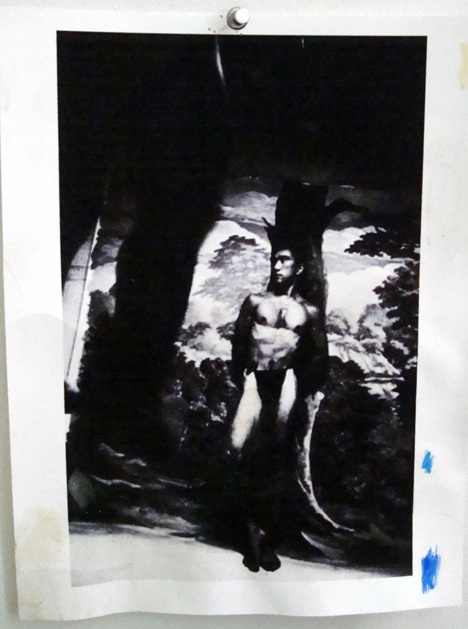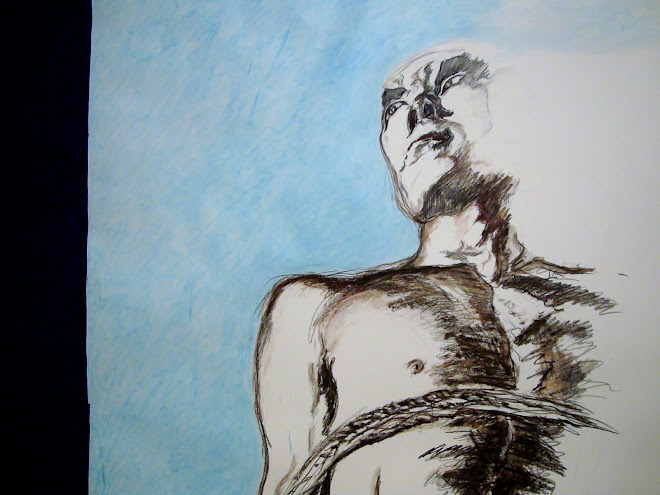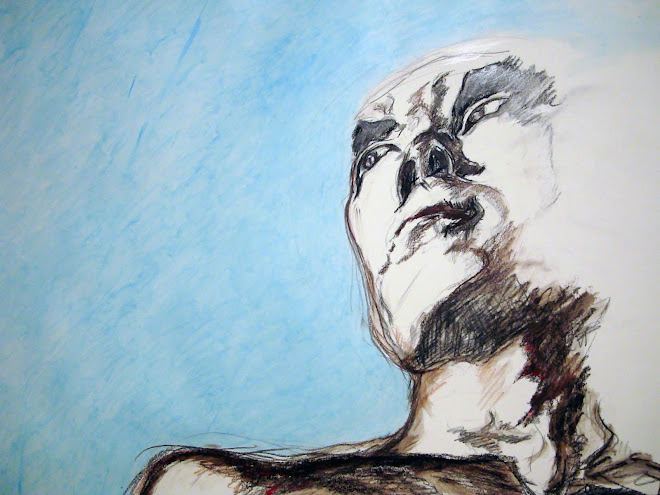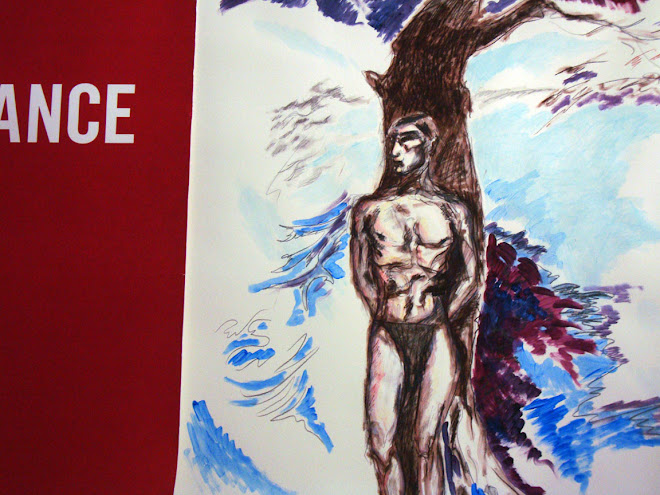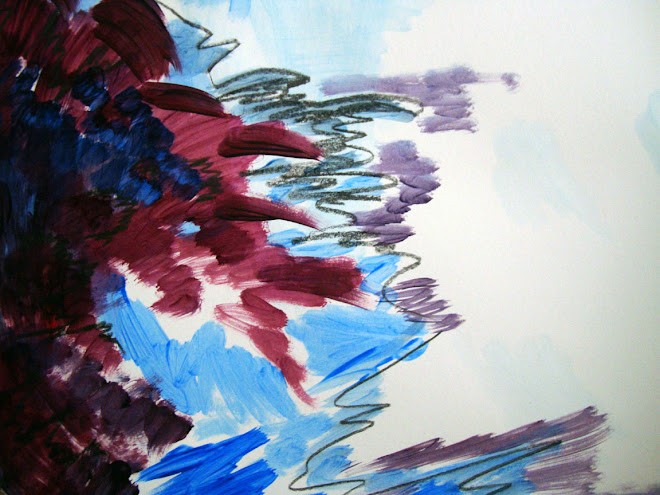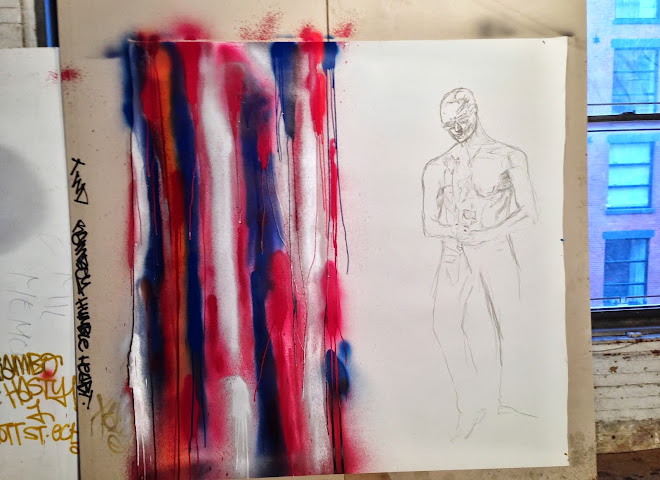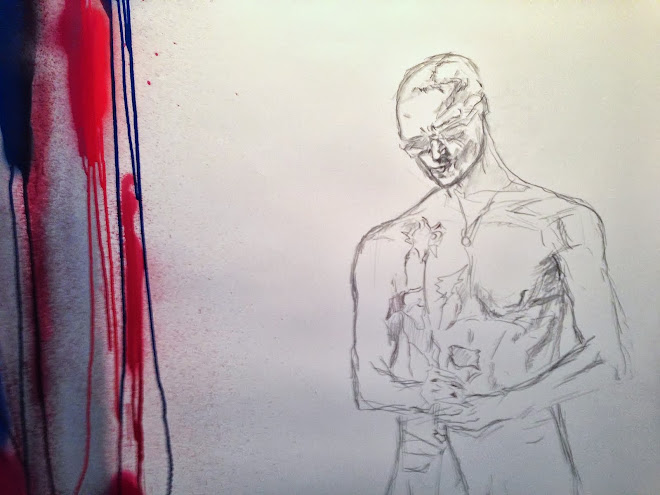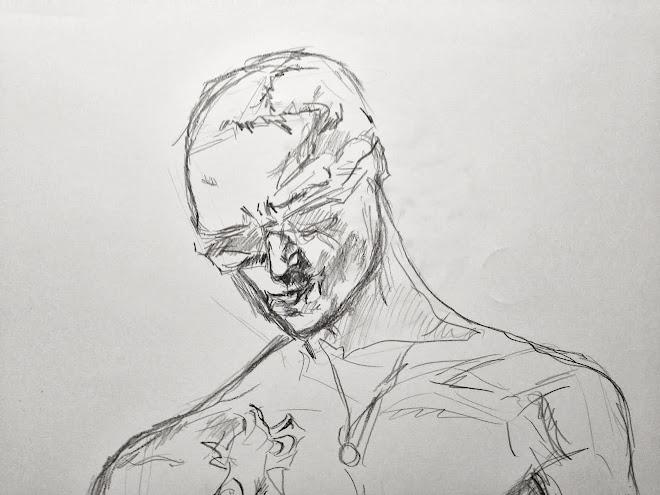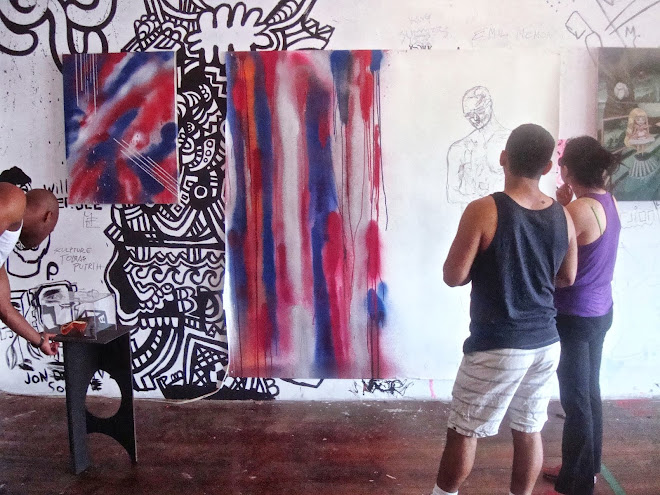The “Blue Movie” deals with a couple of basic elements: the body, literature, and the city (New York), as well as the inner structure of an image, and cinematic rhythm. The nature of the image itself produced a static offshoot of this work that consists of large photographs and metal panels. At that time, I wanted to merge music with my work, so at different occasions I presented my movie with three guitar players performing live (mostly noise) as a background to the projection. The imagery is a bit apocalyptic--merging urban decay with deconstruction of the image itself. There is electronic snow over a blue Manhattan skyline which are almost like electrons of nuclear radiation after an atomic blast. The reason for this metaphor is that at that time there was dangerous tension between the U.S. and the ex-Soviet Union: the U.S. was deploying anti ballistic missiles in Western Europe, and Reagan remarked that he would “start bombing in 5 minutes”.
Wednesday, May 25, 2011
ARTIST STATEMENT EMIL MEMON, “1983/BLUE MOVIE”, 1982 / 2004
http://www.e-arhiv.org/arhiv/diva/index.php?opt=author&id=248
ARTIST STATEMENT
EMIL MEMON, “1983/BLUE MOVIE”, 1982 / 2004
The “Blue Movie” deals with a couple of basic elements: the body, literature, and the city (New York), as well as the inner structure of an image, and cinematic rhythm. The nature of the image itself produced a static offshoot of this work that consists of large photographs and metal panels. At that time, I wanted to merge music with my work, so at different occasions I presented my movie with three guitar players performing live (mostly noise) as a background to the projection. The imagery is a bit apocalyptic--merging urban decay with deconstruction of the image itself. There is electronic snow over a blue Manhattan skyline which are almost like electrons of nuclear radiation after an atomic blast. The reason for this metaphor is that at that time there was dangerous tension between the U.S. and the ex-Soviet Union: the U.S. was deploying anti ballistic missiles in Western Europe, and Reagan remarked that he would “start bombing in 5 minutes”.
The “Blue Movie” deals with a couple of basic elements: the body, literature, and the city (New York), as well as the inner structure of an image, and cinematic rhythm. The nature of the image itself produced a static offshoot of this work that consists of large photographs and metal panels. At that time, I wanted to merge music with my work, so at different occasions I presented my movie with three guitar players performing live (mostly noise) as a background to the projection. The imagery is a bit apocalyptic--merging urban decay with deconstruction of the image itself. There is electronic snow over a blue Manhattan skyline which are almost like electrons of nuclear radiation after an atomic blast. The reason for this metaphor is that at that time there was dangerous tension between the U.S. and the ex-Soviet Union: the U.S. was deploying anti ballistic missiles in Western Europe, and Reagan remarked that he would “start bombing in 5 minutes”.
Revisiting this movie twenty years later, this apocalyptic urban vision has unfortunately a new resonance, because apocalypse became reality, so the images from the movie of the twin towers and electronic snow over Manhattan skyline in our age of terror and paranoia have a new meaning. Next to the images of the monumental decaying city, is an experience of a New York City that in retrospect, is hard to remember. This vast, spectacular decay, inspired street culture and art based on it (especially graffiti.) There was also the myth of New York City best represented by Warhol with his movies and the velvet underground; contrasting with the city is my own body in a basic counterpoint to the concrete jungle. To this basic duality I insert a third element--that of literature. I started to work on the movie the moment I arrived in NYC as a Fulbright scholar doing my MFA at Pratt institute. I had no expectations about what this city will be for me. I had one vision of New York formed in my head based on my fascination with what I perceived as underground culture emanating from this town. Very quickly I found my natural stomping grounds in the East Village, where countless other kids followed the same muse. It was fantastic: they were from everyway, from Europe, Japan, Florida or any other spot on the globe. It was glorious and sinister at the same time, because the city was there like Rome already shaped in timelessness, and we were just new flesh and blood feeding this cold pulsating monster. Later on, I was making jokes about new arrivals and how quickly the fresh rouge on theirs cheeks transformed itself into gray patina that transcends all the classes, from rich to the poor. Experiences were condensed, in a short time you lived years. Things could turn ugly very fast. Suddenly people you knew, your young friends started to die of a strange disease. It was as if a nightmare became a reality or biological science fiction; the most outrageous one became reality. That autonomy, that space of freedom that was trying to be carved in lawlessness and decay of Lower Manhattan held a serpent and an apple. In a way, those shots of the city in my movie, driving across the bridges are clichés , but are sincere ones and now are documents of time that is no more and gone. Those cars, WTC, trash in Dumbo, the mother with a child crossing the street on a gloomy Bowery.
When I used my own body instead of my friend’s, I was sensing my own and others fragility. My naked body is surrounded by long shots of a flickering, menacing urban landscape. This machine caught my body, a lady waiting for a bus under the bridge, an old Chinese couple, and a mother in its all fragility trying to bring her baby to safety on the other side of the Bowery. I was alone with the camera in my room with a collection of German Expressionistic poems in my hand. I knew Rimbaud was the big muse of the New York punk and art scene, but I preferred George Trakel, a young Austrian expressionistic poet, who in disgust with the horrors of WWI on the Russian front, committed suicide with an overdose of cocaine. So I was reading those poems in that doctor Caligari room. My words are mute, because they are not meant to be heard, what is supposed to be heard is the hum of the film projector, the noise of 3 or 4 electric guitars my friends were playing, or just silence and the thoughts of the viewers. Standing there with the light coming through my window and washing over my body, I was thinking of a couple of years earlier in Florence as an art student and of Leonardo’s chiaroscuro. I reduced everything to basic turning on and off of the camera and my body on auto-erotic mode.
Text I wrote about America for the Slovenian EMZIN magazine/ Issue Amerika
AMERICA
I was asked by the publisher to write something on United States of America. The premise is that is a place of contradictions, power that defines the destiny of the world past 100 years in good and bad. And that exactly what it is.
There’s a history of Anti- Americanism since it’s beginnings starting with the European colonial powers, England being defied in a gruesome war of independence, later war with France in Quebec and Spain over Cuba, Philippines. Mexico being totally humiliated by loosing Texas, California. and having American troops marching into Mexico City. From the beginning the Monroe doctrine was designed to keep European powers from Western hemisphere and that didn’t endire Americans to the European ruling elites (image of ugly and crass American). US was claiming it was keeping away bad colonials. As for Asia, commodore Perry by sailing his battleship into Tokyo harbor opened Japan to outside world and trade, US took Philippines from Spain. In North Africa the birth of American navy happened by chasing Arab pirates of the coast of Morocco. Basically America was fully engaged from the begiginings in the world’s affairs. In Latin America marines were engaged in over 5000 interventions, like in Nicaragua, Salvador, Porto Rico, Dominican Republic, building and controlling Panama Canal. And all of this only in 19 century and first years of 20th.
America it’s a warrior nation and very successful at it. It did win couple of good ones, luckily for us. It’s a nation in a permanent state of war. It is also a nation in war with itself, starting with its original sin when declaration of independence was written about equality of man that didn’t include African Americans and that instituanilezed slavery. That is a crucial element in understanding America, from this many crucial things emanate; from horrific Civil war, Crow laws in the South with segregation, violence and lynching of blacks and to great things, like the American democratic and progressive traditions being generated around this conflict that influenced the world. The struggle for Civil liberties and Martin Luther King helped other oppressed minorities to fight for their own rights and slowly trough legal process started achieving them; women’s, gay’s & transgender, Latino’s and other minorities rights, etc. This conflict and the tensions generated by it is central to great American art, like Jazz, Pop and Rap, entertainment in large including Hollywood, literature and is defining visual arts since Abstract Expressionism till today. One side of the coin has a lot blood on it, including oppressive global economical system shaped and enforced by US, the other has opposite value, power that exported liberating modernizing ideas of individualizzem, struggle for civil rights for oppressed, gender & race studies, arts & entertainment and technology that is constantly trasphorming lives, including the way this article is written and transferred and printed. So you can dive into the bad and ugly or good (as a great Sergio Leone Spaghetti Western movie was called, but in different order:” Good bad and ugly”) and liberating at your pleasure. It’s plenty to explore and see on each end and the grays in between. It’s up to you to individualize your take on America and all are pretty much correct and wrong at the same time. Maybe this schizoprechnic reality makes people around the worlds so passionate and Anti Americanism virulent and deadly as it’s support that can also turn bloody. The main misunderstanding for people looking at the US from outside is the simplification of decision-making process and the acting upon the world by the States. It’s seen as a monolithically as a single entity or mind injecting itself and enforcing it’s will upon the world. Like recent war interventions in Persian Gulf, Bosnia, Serbia & Kosovo, Iraq and Afghanistan and so called permanent war on terror. That misunderstanding makes things simple and especially appealing for vision of the world that is run by conspiracies. But because, as I previously mention, of America’s war with itself as a constant process, that is absolutely wrong. It’s internal debate is messy, chaotic, and because of it’s original sin and constant interspection that it created, it is democratic, laud and incomprehensive. This doesn’t mean that decisions made are good, they can be very lousy, sometimes can be the right ones. Good example of this in foreign affairs was the debate around intervention in Bosnia and Kosovo. Well, that fact doesn’t make much difference to a family that was being wipeout by a bomb, dropped by mistake, but maybe it does to a girl being able to go to school and maybe take a little more control over her life and body. Well, as a friend of mine put it with irony, American soldier as gallant protector of Afghan women in the discussion we had abut NATO living or staying in Afghanistan. Take your pick. Dammed if you don’t do it {Rwanda, Sarajevo…), dammed if you do it (Sadam, Taliban…). The burden of the White man as the British colonials put it, so called taking responsibility for the “primitive” natives as excuse for squeeze and economical exploitation. One thing, to be literal, is that US is no more a White nation, is as close to what there is of a global society, unlike Europe that so much of it’s life and unease is derived from blood and soil. In next decade or sooner European stock will be minority and here is where the vitality of American culture kicks in, it’s multiculturalism. (No mistake, this is not easy internal process, with a lot of ugliness, specially now with a hysteria, pressure and violence on illegal and legal immigrants. Hopefully in the end it will move in the right direction, soul of the country depends on it, not unlike Civil liberties struggle in the 60’s).
There is a tendency in our human nature that power vacuum is always filled. One contended is the West with its internal long process in philosophy of liberating individual from simple mindedness of religious oppression of Christianity and dialectics & humanism becoming part of thinking process and after the horrors of producing 2 WW while dividing the colonial wealth, producing the worst genocides since Lucy, devising the most lethal forms of annihilation, exploding nuclear bombs on cities and immersing in perversion of exploitations (Conrad’s the heart of darkness), there was some sort of exploration of it’s bad consciousness and a guilt trip, that instutinalized itself among others in formation of EU and its laws and in it's almost impossible birocracy. The other force there is to fill the vacuum of power right now is the newly refreshed, after the latest economical collapse produced by US’s Wall St., victorious Chinese model (Singapore, original South Korean, Saudi, Dubai etc.) of economical progress (Rupert Murdoch loves it as do other corporations that go along with and enforce Chinese government repression of free speech and dissent) granted by dictatorship, wanting to recapture the felling of its own rightful place of national grandeur, inflaming nationalism to replace the youthful Tien=namen Sq. desire for democracy, after historical humiliation inflicted by the West, which is basically what is the premise of fascism. So once again it’s simplicity of good or bad option or something in-between. Obviously something in-between a 3 way is more preferable, because if there is time for a process to produce something as a more inclusive, economically just and humane way of the world affairs that is the choice the right one, but is there time and process in place to produce that or there’s no time and the choice is the US & West chaotic democracy or part of it or so called Chinese model that with time will merge with transnational corporations, that are finding its control of people and work force very appealing to maximize their profits and democratic process of debate and fights for workers rights and unions a nuisance, sort of what happened in Germany when the money class put Hitler in power to stop the liberating social movements in Weimar republic. This is happening on global scale. It’s pretty scary where things are moving to, specially amplified by climate change and scarcity of resources. Is the current enormous capacity of US war machine good or bad?
So, take your pick.
As our glorious poet France Preseren put it “ shoes be only judged by Kopitar” or something like that, meaning that a sate burocrat shouldn’t judge poetry, so me as a Visual Artist writing sort of a foreign affairs paper is not appropriate, but as to [Adetti di lavoro) as is called in Italian, visual art professionals know, that politics is integrated as a main element in art. Basically as Beuys told us that everybody is an artist & can use art as a tool for political transformation and Warhol that everybody is a star for 15 minutes maybe Kopitar today could have something valid to say about Presern poems. Democratization of expression and culture that happened trough ideas and works of art since beginning of modernism and amplified by new technology we are immersed in right now, has big part of American DNA in it. There’s also NYC, the actual space where the global exchange, literally from person to person, artist to artist takes place. It’s a magical place. Influence of American visual artists from Rothko, Pollock, to Jasper Jones, Rauschenberg, Cage, Warhol to Basquat, Haring, Koons, merging high with low, pop culture with highly conceptual work, sort of good and bad and ugly, that alchemy of this transformation to ever more democratization of creative power did happened in the US and in its imperfection did maybe unleashed and empowered individuals all over (It also produced a shift in geography of established Visual Arts that previously was exclusively domain of European and American artists, now contemporary art market includes global production). This is sort of unintended byproduct of American dominance and globalization it unleashed, power to project information. Like Hip Hop expression of Black urban America, it’s genesis in that original American sin, merged with Dance Hall from poor country of Jamaica and now trough the power of American commercial media morphed in becoming language of protest of the poorest and dispossessed from all over. So that creative empowerment of every women, man & child coming from the arts will hopefully provide that 3 way between Good, Bad &Ugly.
Well, it’s wishful thinking.
Emil Memon NYC,September 2010
Wang Qingsong-Past,Present,Future/review of Chinese photography at ICP
ICP International Center of Photography Asia Society and Museum New York June 11-September 5, 2004 Curated by Wu Hung and Christopher PhillipsWang Qingsong, Past, Present, Future, 2001, digital c-print (triptych)
In the last few years, Chinese art has been slowly introduced by a group of its dedicated champions to the West, and especially to the New York contemporary art world. As with other so called new markets, a group of westerners, in this case cultural entrepreneurs descended into the new territory and carefully selected and guided a group of talented young Chinese artists who emerged as the first generation after the Tianamen square massacre. Several generations are trying to transcend or ignore the political past, and with the rest of the Chinese economy to catch up on western technology — in this case cultural technology.
There are some similarities in style and sensibility with artists from other post dictatorial societies that recently opened up (like so called Eastern Europe or South America). There is a difference since Chinese society underwent a successful, rapid economic modernization and hard core economic capitalism–but not political pluralism–and actually so called “communism” is guaranteeing its economic success. This condensed, short time frame of changes and contradictions gives the show its unique quality, and the result is one of hard-edged beauty.
Owing to the erudite knowledge by a specialized, small circle of academics, art critics, curators, art dealers and collectors, Chinese contemporary art exploded with a bang in a series of well timed and organized exhibitions and publications, into the consciousness of the large mainstream art world. Chinese contemporary art arrived into the warm embrace of the contemporary art market, mirroring China’s spectacular success in the world economic markets. There were previous large presentations of Chinese contemporary art, notably the exhibition in 1999 at Asia Society and P.S.1, however, this exhibition joins fresh new faces with what are now almost classic works of Chinese contemporary art. There emerges a strong group of artists who are self-assured and well equipped with knowledge of the global media and whose work goes beyond the hackneyed east vs west dichotomy.
There is a stellar photographic work at ICP by Wang Qingsong that impresses the viewer with its large scale imagery and panoramic format. Updating a famous Tang dynasty painting “Night Revels of Laoli”, the artist stages replaces the original court figures with important figures in contemporary art scene in China (the art critic Li Xianting) and himself into a grand court scene–his version of the Warhol factory. Equally striking is his work at the Asia Society, where with the triptych “Past, Present, Future” he stages his figures into a tableaux vivante referencing imagery of Chinese social realism of the not so far past. Heroically-posed figures in mud, silver and gold are representing different phases of China. He is using staging almost as a Baroque painter would do, so it is not surprising that he moved with his latest body of work, also presented at this time in NYC, to the western art historical themes.
Another powerful work is that of Zhang Huan, whose photograph incorporate reference to body art of Chris Burden or Vito Acconci but in the much more squalid environment of a public toilet with honey and flies over his body. He endures the pain that we can sense with Zen-like patience.
Zhao Bandi with his Panda are also present at this show. His sidekick is a toy panda representing China. His work is such that you must have knowledge of Chinese cultural, social and physical landscape. His work is a simple, gentle, charming social parody but graced with extraordinary beauty. The example in the show is good, but he works better in accumulation (as a series of photos), because he and his Panda grow on you..
In an old-school type of conceptual work, like something from the 70′s, the Beijing based artist Song Dong is stamping water with a stamp that says water. It is a beautiful gesture, and makes you nostalgic for simpler and pure times. The fact that is a series of photographs on the wall, documenting the performance makes this impression stronger.
There is a lot to see in the exhibition (for instance, the powerful work of Qui Zhijie), and there are plenty of other works and many other artists that will catch your attention. This is not only an exhibition for people with a special interest in China, but for everyone that likes good art.
“Between Past and Future: New Photography and Video from China” is Curated by Wu Hung and Christopher Phillips. It is the first comprehensive look at the innovative photo and video art produced since the mid-1990s in China, and will be presented jointly at the International Center of Photography and the Asia Society and Museum from June 11 to September 5, 2004.
This traveling exhibition continues on to the Smart Museum of Art, University of Chicago, and Museum of Contemporary Art, Chicago (Oct. 2, 2004-Jan. 16, 2005), Seattle Art Museum (Feb. 10-May 15, 2005), Haus der Kulturen der Welt, Berlin (March-May, 2006), Santa Barbara Museum of Art (Summer 2006)
New York, August 2004
Contact us:
285 East 3rd St, 2nd Floor (between Ave C & D) Phone: 212-674-3778
Fax: 212-674-5776
Email: info@tribes.org
Subscribe to:
Posts (Atom)
